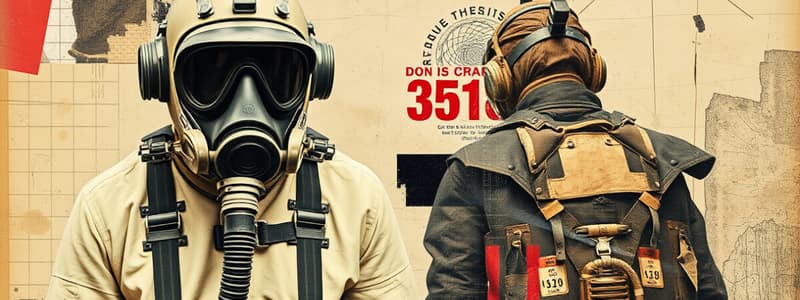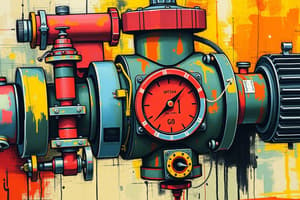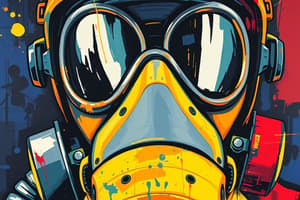Podcast
Questions and Answers
What must be generated in conjunction with the Out of Service Tag?
What must be generated in conjunction with the Out of Service Tag?
- A Safety Report
- A Work Order Ticket (correct)
- A Maintenance Log
- An Inspection Record
Which detail is NOT required on the Out of Service Tag?
Which detail is NOT required on the Out of Service Tag?
- Date of reporting
- Location of the asset
- Asset serial number
- Repair cost estimate (correct)
What information must be provided about the problem on the Out of Service Tag?
What information must be provided about the problem on the Out of Service Tag?
- The technician's qualifications
- A description of the problem (correct)
- A detailed repair plan
- The warranty status
In what format should the asset's identification number be noted?
In what format should the asset's identification number be noted?
What does the acronym 'SER.' stand for in the context of the Out of Service Tag?
What does the acronym 'SER.' stand for in the context of the Out of Service Tag?
What is the main purpose of the primary screen on the SCBA?
What is the main purpose of the primary screen on the SCBA?
Who is expected to sign the Out of Service Tag?
Who is expected to sign the Out of Service Tag?
What affects the accuracy of the remaining service time displayed on the SCBA?
What affects the accuracy of the remaining service time displayed on the SCBA?
What is the primary purpose of affixing the Out of Service Tag to an asset?
What is the primary purpose of affixing the Out of Service Tag to an asset?
Which of the following should be included in the 'Location' section of the Out of Service Tag?
Which of the following should be included in the 'Location' section of the Out of Service Tag?
How long should the facepiece be submerged in the Confidence Plus Germicidal Cleaner?
How long should the facepiece be submerged in the Confidence Plus Germicidal Cleaner?
What should you do if there is moisture on or in the facepiece?
What should you do if there is moisture on or in the facepiece?
When should the date be entered on the Out of Service Tag?
When should the date be entered on the Out of Service Tag?
Which step must be performed before returning the facepiece to service?
Which step must be performed before returning the facepiece to service?
What is used to clean the pressure-demand exhalation valve?
What is used to clean the pressure-demand exhalation valve?
What does the SCBA unit identifier assist with?
What does the SCBA unit identifier assist with?
What does the countdown timer on the primary screen indicate?
What does the countdown timer on the primary screen indicate?
What should be used to clean a soiled SCBA?
What should be used to clean a soiled SCBA?
Which of these components is NOT part of the SCBA?
Which of these components is NOT part of the SCBA?
What cleaning agent must NOT be used on the SCBA?
What cleaning agent must NOT be used on the SCBA?
Why should the regulator outlet be covered during cleaning?
Why should the regulator outlet be covered during cleaning?
What should not be done to clean SCBA components?
What should not be done to clean SCBA components?
What is a potential consequence of moisture in the facepiece or regulator?
What is a potential consequence of moisture in the facepiece or regulator?
Which of the following statements is correct about cleaning SCBA?
Which of the following statements is correct about cleaning SCBA?
What is the best practice after cleaning SCBA components?
What is the best practice after cleaning SCBA components?
Flashcards are hidden until you start studying
Study Notes
Primary Screen Information
- Displays critical information for the user, including a calculated remaining service time for SCBA.
- Countdown timer indicates the estimated rated service pressure until it reaches 35% remaining.
- Actual remaining time may be less than displayed due to variations in breathing rates.
- Displays time is based on the average breathing rate over the last three minutes.
- Increases in breathing rate can significantly reduce available time.
SCBA Unit Identifier
- Each SCBA is equipped with a corresponding unit identifier for quick visual identification.
- The identifier is secured to the carrier band of the apparatus.
Facepiece Cleaning Protocol
- Remove the facepiece-mounted regulator for cleaning.
- Prepare Confidence Plus Germicidal Cleaner solution as per label instructions.
- Submerge the facepiece in the cleaner for at least 30 seconds.
- Use a soft brush or sponge for cleaning; rinse thoroughly in clean water under 110°F.
- Clean the pressure-demand exhalation valve by flushing it with clean water using a blunt object.
- Verify proper operation of the exhalation valve and ensure no moisture remains before returning to service.
- Conduct a negative pressure seal test before using the facepiece again.
Harness and Cylinder Cleaning
- For heavily soiled SCBA, use a mild soap solution with a sponge or a soft/medium bristle brush.
- Cover the regulator outlet to protect from water, dirt, or debris during cleaning.
- Key components to clean include harness, carrier, cylinder, pressure reducer, control module, and battery module.
Cleaning Considerations
- Avoid substances that can damage SCBA parts: no bleach, alcohol, hydrocarbons, or solvents.
- Do not use radiant heat for drying; pressure washers are also prohibited.
- Ensure components are thoroughly rinsed and dry before returning SCBA to service to prevent freezing.
Maintenance Reporting System
- Maintenance of saws involves a dual reporting system: a Work Order Ticket and an Out of Service Tag.
- Work Order Ticket generated in Vector; a physical out-of-service tag is affixed to the equipment.
- The out-of-service tag requires:
- Date of reporting
- Inventory Identification Number (SER.#)
- Location (Station and Unit)
- Description of the problem
- Signature of the person reporting the issue.
Studying That Suits You
Use AI to generate personalized quizzes and flashcards to suit your learning preferences.




